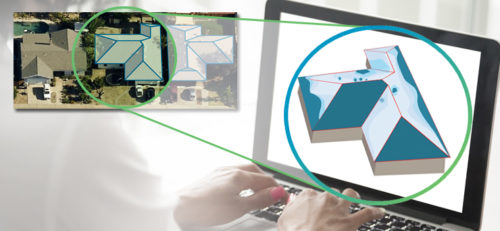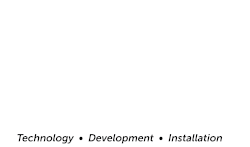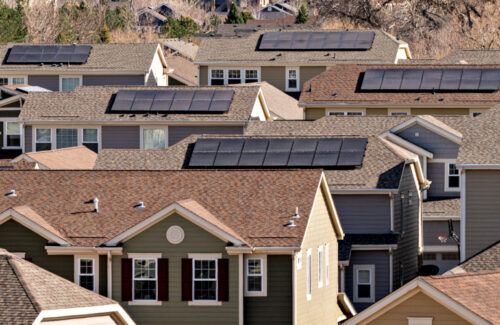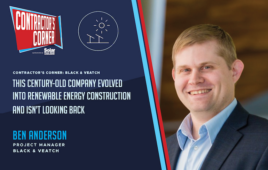By Pete Cleveland, VP of solar, EagleView
In competitive residential solar markets, a solar sales and installation company competes with an average of 20 solar businesses for customers, referrals and market share. For many companies, the pressure to stay competitive has emphasized a new need to reduce system costs.
While overall system costs in the United States have declined by 25% since 2014 largely due to technology advancements, customer acquisition and overhead costs have increased by 31% during the same time. According to SEIA, soft costs in the United States represent 60 to 70% of the total cost of residential-scale solar PV systems.
This disparity between rapidly falling system hard costs and the generally increasing percentage of soft costs point to the importance and opportunity of soft cost reductions.
Reducing soft costs to scale business
 Soft costs represent the costs outside of hardware equipment associated with selling, designing and installing a solar PV system – including customer acquisition, design, permitting, installation, inspection, interconnection, business overhead and profit.
Soft costs represent the costs outside of hardware equipment associated with selling, designing and installing a solar PV system – including customer acquisition, design, permitting, installation, inspection, interconnection, business overhead and profit.
Overhead (general and administrative) and profit make up a project’s largest expense, representing 21% of the total system cost. Sales and marketing come in a close second with 18% of the total system cost.
Rather than sacrificing profit margins to narrow costs, companies have an opportunity to evaluate their sales and operations workflow to first pinpoint inefficiencies and then identify high-impact solutions to streamline operations. Customer acquisition and related sales and design activities, in particular, are a great place to start.
Prioritize accurate site assessment data
Site assessment data is foundational to the solar sales and installations process. Roof size, usable square footage and sun exposure are all data points used throughout a project’s sales, planning, installation and close-out phases.
Inaccurate site measurements result in less profitable jobs in the best case, and canceled contracts and lost referrals in the worst. On the flip side, high-quality site measurements result in a quick sales cycle from lead through installation, which speeds payment and cash flow.
Fortunately, new advancements in remote measurement allow solar companies to bypass inefficient and error-prone site visits to measure and record roof dimensions, azimuth, pitch and localized shading at a given site. Additionally, some remote measurement technology, such as those that derived from aerial imagery, captures thousands of measurement points. In comparison, the same rooftop measured manually with a hand-held device captures perhaps only a few dozen values.
Streamline the design process
 Traditional solar sales processes begin with sales representatives using preliminary system designs from a do-it-yourself software to develop an initial proposal that estimates how many solar modules will fit on various roof facets. In this preliminary design process, many contractors purposefully underutilize roof space to avoid issues at final design or installation. (Under-sizing a solar PV system may help mitigate risk but doing so adds to soft costs, leaves money on the table for the contractor and negatively impacts return on investment for the homeowner.)
Traditional solar sales processes begin with sales representatives using preliminary system designs from a do-it-yourself software to develop an initial proposal that estimates how many solar modules will fit on various roof facets. In this preliminary design process, many contractors purposefully underutilize roof space to avoid issues at final design or installation. (Under-sizing a solar PV system may help mitigate risk but doing so adds to soft costs, leaves money on the table for the contractor and negatively impacts return on investment for the homeowner.)
Once the contract is signed, a technician then performs a site visit to collect the necessary measurements and information to validate a final system. Unfortunately, the chance for human error when using a hand-held device to log measurements is high and can lead to costly mistakes down the line.
With remote measurement technology, however, virtual site assessments employ satellite or aerial imagery to capture data – including all roof measurements, pitch angles and even obstacles such as plumbing vents and skylights – to output a detailed 2D or 3D roof model. Energy production estimates and visual rooftop solar layouts can be developed before any direct customer engagement. Not only does this prepare the salespeople for a well-informed first communication with a potential customer, it also optimizes outbound sales efforts by prioritizing homes with favorable roof facets and solar access values in the sales queue.
Coupling high-accuracy remote measurement and high-resolution imagery with solar design and layout software tools efficiently delivers installation-ready designs on the front end of the sales cycle, eliminating the need for “preliminary” designs altogether. These designs are also optimized to fit more modules on the average rooftop and maximize annual solar energy production.
Advantages of an optimized workflow
Inefficiencies in traditional solar sales and operation workflows often begin with inaccurate roof measurements that lead to overly conservative designs, excessive truck rolls and change orders, and result in longer timelines that ultimately dig into a project’s profitability. There’s also a greater risk of canceled contracts, unhappy customers and lost referrals.
Fortunately, implementing high-accuracy data tools that facilitate virtual site assessments and installation-ready designs at the proposal stage offers solar companies significant opportunities to streamline workflow and gain a competitive advantage and market share within their service area. By optimizing available roof space, shortening project timelines, reducing labor and the opportunity for human error, companies can increase profits, customer satisfaction and their ability to scale.
Competitive and growing solar installers that target customer acquisition costs through virtual assessments and installation-ready designs on the front end of a project will significantly improve workflow efficiencies that in turn support better business processes across the board. Changes such as these, which accelerate sale-to-install time and optimize system performance, are ultimately what will be needed to scale the solar industry to achieve global clean energy goals.
Pete Cleveland is Vice President of Solar at EagleView, a leader in innovating accurate and precise solar design software solutions through aerial imagery and machine learning-derived data analytics.






I think that the soft costs are getting out of control with the rising dealer fees and commissions for salesman taking advantage of homeowners who want to get fixed rate on their energy costs. Companies are charging outrageous price per watt exceeding $4. I was told to charge as much as $7/watt at 1 company. It needs to be controlled. And not at a soft cost addition.
“Overhead (general and administrative) and profit make up a project’s largest expense, representing 21% of the total system cost. Sales and marketing come in a close second with 18% of the total system cost.”
The problem with “soft costs” is that cities and counties are getting involved to feed their local and regional tax base. For instance, one solar PV system I had installed was pretty straight forward and city and county fees for permits were reasonable. The second system I had installed on another home (had) to have a wet stamp by a Civil Engineer and a wet stamp by an Electrical Engineer at $1K per stamp before the permits were generated for the installation. I could have had a few more solar PV panels installed if I didn’t have to pay the soft cost of Engineering stamps on construction plans. I’m thinking for a while at least soft costs for solar PV installation companies have been permanently changed due to Covid-19 and better solar PV siting and prediction tools available for online system bids and pricing.
Back about 2014 or 2015 a young man knocked on my door. He was from Vivint and was showing me the wonders of a home solar PV installation. I walked him back to the curb and pointed to my solar PV array and told him it was a great investment for me. He looked up, said something like ‘great’ and moved along to the house next door. Vivint filed for bankruptcy shortly after that. New items like SolarAPP may make application and permitting of solar PV installations much easier in the future.